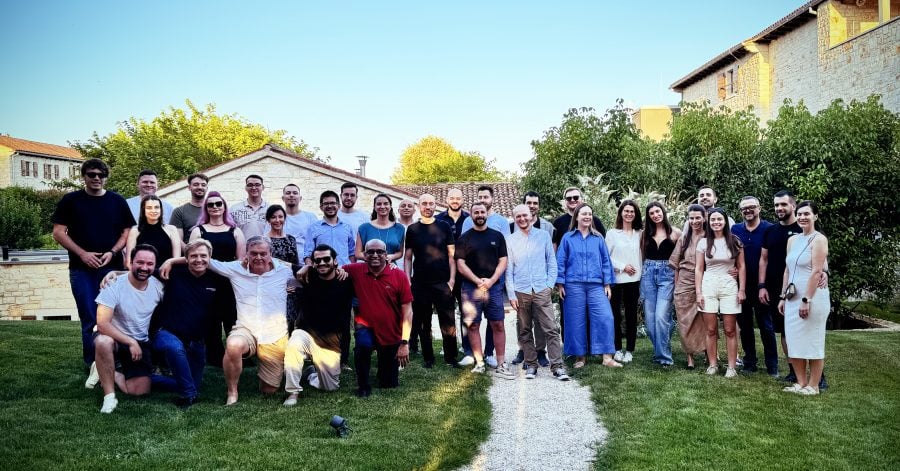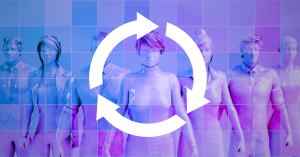In June, The Recursive once again participated in the annual Hellen’s Rock Founder Retreat in Croatia. Our co-founders, Irina Obushtarova and Etien Yovchev, joined another 12 founders from six portfolio companies at the beautiful Meneghetti Wine Hotel & Winery.
This year’s retreat focused on practical problem-solving, fostering deep connections among portfolio founders, candid discussions on pressing challenges, and insights from industry leaders like:
- Sacha Dragic, founder of Hellen’s Rock and Superbet, Romania’s latest billion-dollar company;
- Hans-Holger Albrecht, former CEO of Deezer, one of the largest music streaming services worldwide, and Chairman of the Board at Superbet and Scout24;
- Mark Porter, CTO at dbt Labs and Board Member at Superbet, with previous executive roles at GitLab, MongoDB, Grab, AWS, and Oracle;
- and last but not least Shankar Bhaduri, a seasoned entrepreneur and executive who helped and played a role in growing UiPath from $10M ARR (2017) to $1.05B ARR(2023).
During the first day of the retreat, Bhaduri, a veteran with over 40 years of executive experience, shared invaluable insights on go-to-market (GTM) strategies, a common challenge for young ventures. Drawing from his extensive experience with both large corporations and multiple startups, Bhaduri offered a comprehensive framework for successful market entry and growth.
The Quest for Product-Market Fit
Bhaduri emphasized that the critical importance of achieving product-market fit before scaling a startup. “Till you have validated metrics from a customer that you can scale to other customers, in a market that is existing, it’s size big enough, you don’t have a product-market fit,” he explained.
He cautioned against premature scaling: “Till you know the tracks you’re going to run on, till you know the product market fit is there, no point hiring a big sales team and distribution team.” Bhaduri warned that without a clear product-market fit, a company might succeed to some extent, “go to one, two million dollars per year level, and then get stuck.”
The process of finding product-market fit can be time-consuming. “It could take six months if you’re lucky. It could be one year. It could be two years sometimes,” Bhaduri noted. He stressed the importance of patience, failing fast, pivoting and thorough validation before attempting to scale.
Focus on Achievable Market Size
When discussing market size TAM/SAM/SOM, Bhaduri advocated for a practical approach focused on the near future. “The focus here is your market size you are approaching in the next 12 months,” he said. While targeting a large overall market is important, it’s crucial to identify what’s realistically addressable in the short term.
“Think about that market,” Bhaduri advised. “Within that, because of your differentiator, because of what you offer, because of where you are resourced, you can get a slice of that, so from that billion-dollar, it may come down to, say, 100 million. And then out of that, you realize, this 40, 50 million is what I need to focus on, which is something I can service, something I can deliver, do after-sales, do customer success, and actually take it to complete delivery in the next 12 months with complete customer satisfaction.”
A Comprehensive Go-to-Market Framework
Bhaduri presented a five-block framework for go-to-market strategy:
- Value Proposition and Product-Market Fit
- Content Creation
- Demand Generation
- Lead Management
- Sales Process
“Once you’re sure about your value proposition, then you have to focus on the content creation,” Bhaduri explained. This involves creating a story around the product, defining the message, identifying buyer personas, and developing pitch materials and proof points from customers.
He also emphasized the importance of relationship-building and branding in the long term. “You’re talking about longer-term scaling, right? So here, of course, you do events. You do influencer programs. You enlist different activists, analysts, media activists.” It is an ongoing process.
The Power of Community and Customer Advocacy
One of the most powerful strategies Bhaduri shared was creating a user community. “At UiPath, we started it very small as Daniel’s idea,” he recalled. “He said I want to talk to the real people who are using my product. Today, UiPath has two and a half million users in this community.”
Such a community becomes a valuable source of product feedback and direction. “It will help you prioritize your product roadmap, prioritize how you build that product and sequence it,” Bhaduri explained.
He also shared a powerful shift in their event strategy: “We had an early evangelist who did it for the first year. And then after that, we changed our policy. Nobody from the company talks alone on any forum. It is like they will be there just to facilitate the discussion, but it’s always the customer who talks about how good our product is.”
Value conversation and sales team enablement
Bhaduri stressed the importance of tailoring the message to different stakeholders within a customer organization. “Management team, they look at the problem in different ways. For them, the value propositions are different,” he explained. “When you go to the actual team who is using the product, for example, the development team, they expect different value propositions, really.”
He introduced the concept of “value cards” to help tailor these messages. “For each of the product market fit, and for each value driver you write down, you define, who is my customer, who is my reference, what are the value metrics for that end use.”
“This concept ensures that everyone in the company, from the CEO to the newest hire, can articulate the company’s value proposition consistently. “The CEO probably knows what he or she has built, but the last person in the company, the most junior person who’s facing the customer, should be able to articulate the exact same value proposition that the company has created,” Bhaduri emphasized.
He stressed the importance of enablement across the organization: “Do enough sessions, training sessions, formal, informal, gamification, do some testing, do some question-answer sessions, do some feedback sessions, learn from who’s doing it better than others, let them learn from each other.”
For insights from last year’s retreat check:
How Mindsets and Strategies Create Great Companies








